The Celts and Celtic Life
Introduction
Britain was well into the Iron Age. The natives had the ability to craft everyday items from metal. From the currency to weapons and transport, metal was an integral part of life. This linked page shows the approximate distri-bution of the tribes and links to more detailed pages of information about each one. The map to the above shows Northern Britain and the one below, Southern Britain... |
Assessing the extent of each tribeFrom records, it is has been established which tribes were present in the land at which time. One of the best indicators of the extent of each tribal province was by examining the currency. Each tribe would manufacture it's own coins from base metals mined throughout the land. They put on these coins an image of the head of their leader at the time. This means that by analysing were the coins have been found, which date they show and matching them against records, it can be established were the borders of each tribe were drawn. The philosophy of the tribesThe tribes were extremely territorial and believed that war was a necessary part of everyday life. A part of common existence. In the long winter nights, the tribes would hold gatherings were their would talk of their past victories, battles and the exploits of heroes of the past. The Celtic community
A tribe would be organised into individual kingdoms with each having it's own ruler who was the monarch of the tribe. Around them would be the members, each having their own status within the community and their own responsibilities. Most of the income for the people came from the land in the form of arable and livestock farming. Growing cereal crops such as wheat and the rearing of livestock of which cattle and sheep where the main source of meat. This was very much widespread throughout Britain and Europe, which made trade with the continent a viable business. If a country lacked certain items, they could buy it from elsewhere or exchange goods with their neighbours. The British preferred to barter in goods rather than money On the subject of the tribes, Pytheas, a historian of the time recorded : This wheat the natives thresh, not on open floors, but in barns because they have so little sunshine and so much rain. He also wrote : They (the British) refuse to accept coin and insist on barter, preferring the exchange necessities rather than fix prices. It is interesting to note that this attitude to bartering goods was still very strong in the period directly before the first Romans, who were avid coin makers, came to Britain in large numbers. The first coinage that we have evidence if did not appear in Britain until the second century BC. This did not mean that Britain was inhabited by total savages set in their old ways, far from it. Diodorus Siculus said :
In this, the time of the Iron Age, the British were very advanced in the production of items from metal, in particular tin from the mines of Cornwall where the raw materials were abundant. From the metals the Celts could forge and shape nearly anything, especially in bronze, of which tin is a major component They were able to manufacture almost anything from the finest swords, spears and chariots to intricate designs on jewelery worn by the aristocracy. Considering their, by today's standards, primitive tools, their achievements were outstanding. To mention only two instances of the ancient Celtic crafts would be an understatement. But the two most notable and best preserved items are : 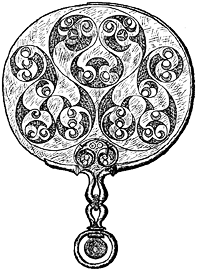
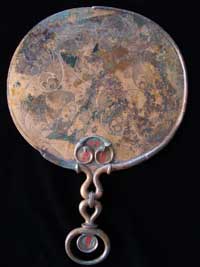 The mirror found at Birdlip, Gloucester,
which has the most elaborate workings on the enamel inlays in the
handle.
The mirror found at Birdlip, Gloucester,
which has the most elaborate workings on the enamel inlays in the
handle.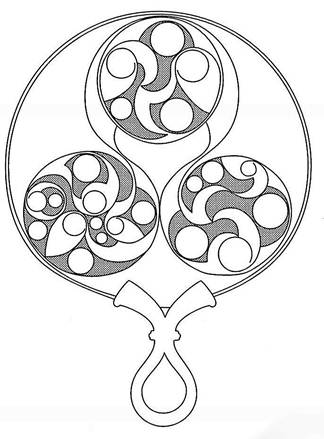
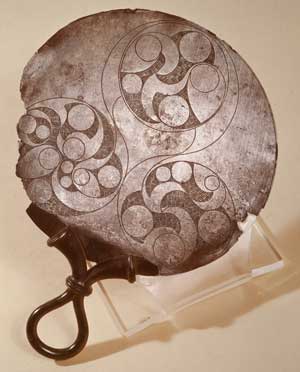 The Mayer Mirror, taken from the River Thames,
which is totally stunning.
The Mayer Mirror, taken from the River Thames,
which is totally stunning.Metal was not the only material they could make into artefacts., the British were also very adept at making items of clothing from materials made to a high standard. The cloth trades were more towards the east of Cornwall were the tin mines were less concentrated. The most valuable item of attire was the sagum which was a woolen cloak worn by the Roman upper classes. To own such an item gave the impression of the wearer being in the height of fashion. In the lead up to the initial expedition, Caesar's report to Rome made very interesting reading, for it painted a picture of a savage and backward society. This was far removed from the general opinion of the Romans, who regarded the quality of British goods with envy and awe. War and battlesIt was not possible to directly compare the strength of one tribe with another since they were all very similar and the only real difference was the actual numbers in each tribe. Without a good knowledge of the opposing tribe, a leader would not potentially sacrifice their own throne for the sake of a needless war,. War was only declared if it was thought necessary and their chances of winning were good. War was common amongst these tribes, but there always had to be a trigger of some sort, such as a raid by an adjoining tribe to steal cattle or women to spark a full scale confrontation. A young warrior would not be allowed to enter into battle until he had proved his manhood. He managed to prove himself in open display without the need to confront an enemy in battle. as is described below. Celtic equipmentThe tribes had basic swords and weapons, along with their own techniques of fighting that developed over time. The ancient Britons had chariots in which they would ride amongst the enemy, hurling their spears into the ranks. It is said these chariots spread terror and confusion amongst the enemy. Indeed during the first Roman expedition of 54 BC. the chariots that were most effective against the Legionaries. The standard Roman battle tactics were designed to be used against ground troops, not such fast moving vehicles of war. Which was why the Romans were reluctant to face an enemy employing a method of fighting they had very little experience of. A good video on Celt and Barbarian Weapons Survival of the fittestThese people had a basic attitude to life. They regarded warfare as a part of life, as did many societies of this type throughout the world. It was considered part of their background to have rites that all young men had to perform to pass from adolescence to manhood. This process would show which youths were the fittest and strongest, thereby enabling them to progress into mature warriors. The weaker or puny youths and the physically uncoordinated did not survive and would often be cast out of the tribe. As such they would not survive and so perish when left to fend for themselves. A brutal method, but it ensured that the tribe remained strong and healthy. This did not mean that all weaker youths were outcasts. Those showing a high degree of intelligence would be placed under the care of the priests who would nurture and encourage their talents for the good of the tribe. It was through these people that new techniques and advances would come. Others who did not posess the physical build to be a warrior, would be placed on farms. So there was at least something most members could contribute to the tribe. The Celts in battleThe chariots were the most effective weapon, splitting the enemy ranks and allowing the fast moving warriors to run amongst an opponent's soldiers, slashing at them with highly sharpened swords that dealt out death and severe injury those those unfortunate enough to be a target. The ultimate prize for a Celt was not the victory, but the taking of a human head from the enemy. It was common belief that the whole nature and soul of the person resided here. If a warrior took a head from an enemy, he believed that he took on the heroic qualities of his victim. Heads were kept as trophies and the slaying of an opponent and the removal of the head by a youth was seen as automatic qualification of manhood and he would be accepted as a full member of his tribe. Celtic Battle tacticsEach tribe had their own method of fighting battles. By far the most common was in the use of the chariots to charge into the enemy's ranks, swords blazing out death. Once they had done their work, the soldiers would then join the battle at points where their leaders thought they would be most effective. It is important to mention here, that contrary to popular belief, the British chariots did not have swords jutting out from the wheels ready to take the legs off whoever was in range. This is one of those myths that has been around for so long, it has been taken as fact. An advantage of the Britons trading with Europe was the traveling merchants could also collect information on techniques of fighting used in foreign lands. One such technique, copied from the Germans, used was to ride into the battle on horseback, then to leap from the animal and engage in face to face combat using swords. This was highly effective, as the enemy had expected an attack from warriors on horseback, then had to quickly adapt to a frontal ground advance. As can been seen, this method of fighting was limited to fast assaults where the battle would last a relatively short time. A longer battle involving greater numbers on each side would soon degrade purely due to the physical exhaustion of all involved. |

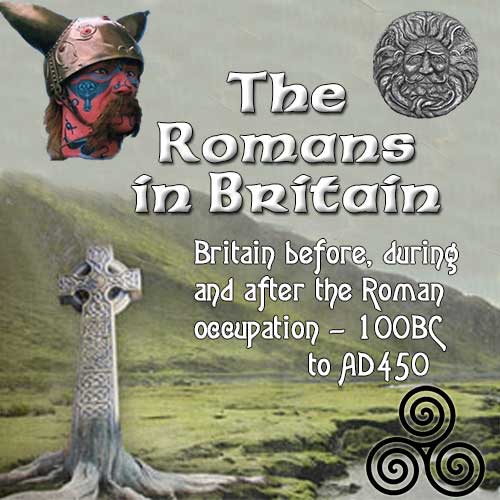
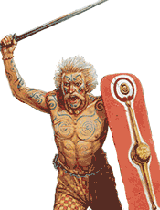
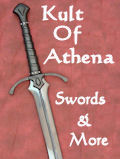


















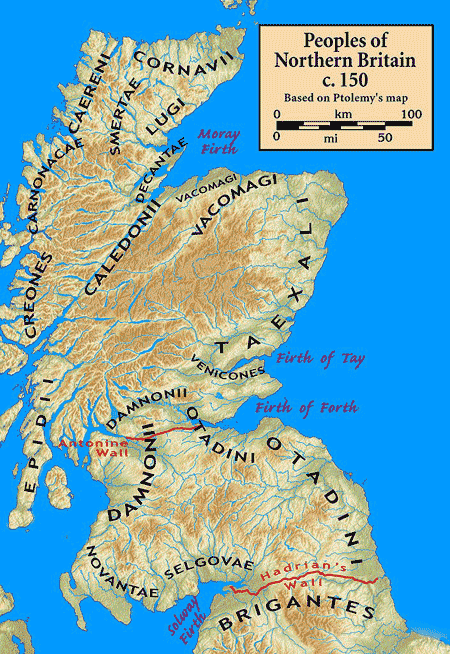 Before looking at the Roman
invasions, it is important to set the scene and get a picture of life in Britain in the
first century BC, which was a time when the country was divided into regions, each
occupied by a tribe.
Before looking at the Roman
invasions, it is important to set the scene and get a picture of life in Britain in the
first century BC, which was a time when the country was divided into regions, each
occupied by a tribe.
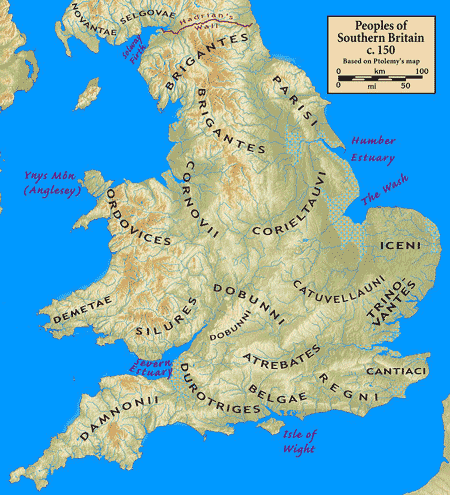
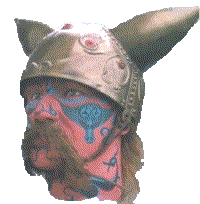 Although Britain was divided into areas ruled by individual tribes,
they all had very similar attitudes to their communities and way of life.
Although Britain was divided into areas ruled by individual tribes,
they all had very similar attitudes to their communities and way of life.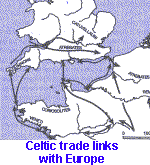 The inhabitants of that part of
Britain which is called Belerion (Land's End) are very fond of strangers and, from their
intercourse with foreign merchants, are civilised in their manner of life. They prepare
tin, working very carefully the earth in which it is produced. The ground is rocky, but
it contains earthy veins, the produce of which is ground down, smelted and purified.
They bear the metal into masses, like astrgali, and carry it to a certain island off
Britain called Ictis. Then the merchants buy the tin from the natives and carry it over
to Gaul, and after traveling overland for about thirty days, they finally bring their
load on horse to the mouth of the Rhone.
The inhabitants of that part of
Britain which is called Belerion (Land's End) are very fond of strangers and, from their
intercourse with foreign merchants, are civilised in their manner of life. They prepare
tin, working very carefully the earth in which it is produced. The ground is rocky, but
it contains earthy veins, the produce of which is ground down, smelted and purified.
They bear the metal into masses, like astrgali, and carry it to a certain island off
Britain called Ictis. Then the merchants buy the tin from the natives and carry it over
to Gaul, and after traveling overland for about thirty days, they finally bring their
load on horse to the mouth of the Rhone.








